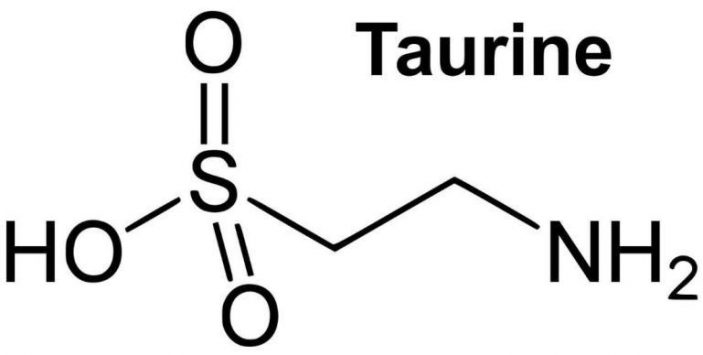What is taurine?
Taurine is a conditional amino sulfonic acid (sulfur-containing beta-amino acid) found in free tissues with its highest concentration noted in the heart, brain, eye retina, skeletal and muscle tissues of most mammals.
Since it does not have a carboxyl group, it is neither an essential nutrient nor true amino acid. However, the AAFCO recognizes it as a vital pet food ingredient with some symptoms associated with its deficiency in cats.
Furthermore, unlike dogs and human beings, taurine synthesis by cats using other ingredients in their diets is limiting. Therefore, they require it to provide in their diets, a reason why you should not feed your cats using dog food.
Usually, felines use this amino sulfonic acid to form bile salts only and degradation will occur by the help of intestinal microflora.

Finally, since enzymic degradation does not occur except for intestinal microflora, its excretion is via urine or as taurocholate and similar bile acids through feces. Since felines quickly metabolize this amino sulfonic acid and it should be replenished daily.
Benefits or why do cats need taurine?
It is important for proper body function and some of the taurine benefits for cats or functions include:
- Aids in normal cardiovascular and heart function as well as in electrolyte balance (osmoregulation).
- Supports GT tract
- Helps in immune response and platelet aggregation
- Ensures normal eye retina functioning
- It “is also important for a cat’s teeth and hair” notes ThomasLabs and helps modulate the flow of calcium into and out of cells.
Natural source of taurine for cats
Some natural taurine-rich foods for cats include small rodents, birds, fish especially shellfish and meat.
Although dairy products have some of this amino acid, most adult felines are lactose intolerant and dairy products are not a good source of this nutrient.
In plants, it is available in trace amounts. Therefore, they are not a viable source.
Finally, besides the above natural sources, you can also choose to supplement it in your homemade and raw feline food recipes if you know the right dosages to use.
Sources in commercial diets
Besides the natural foods high in taurine, where else does it come from? The answer is simple, it is synthesized, the synthetic form can be obtained from isethionic acid ammonolysis, a reaction between sulfurous acid and aziridine or by use of ethanolamine process.
About 50% of the amounts synthesized are used for pet foods while the remainder is used for pharmaceutical purposes.
Supplements
There are many taurine supplements you can buy with the best brands being PetAg and Thomaslab Felo.
How much does a cat need?
According to AAFCO 2014, the minimum taurine required is 0.25g for extruded or dry cat foods while for canned foods, the amount is 0.50g per 1000 kcal of feline food for growth, reproduction, and adult maintenance.
Basing on dry matter, the minimum recommended amounts are 0.1% and 0.2% for extruded and canned foods respectively.
The amount required in canned food is higher due to low bioavailability, especially the heat-processed canned pet foods.
Taurine deficiency in cats and symptoms
A feline is considered to have an adequate intake in its diets when the resultant taurine plasma level is more than 50-60 µmol/L. Home-cooked foods present an increased risk of deficiency especially boiled ones.
According to the European Pet Food Industry, FEDIAF deficiency of taurine in felines “can lead to feline central retinal degeneration, dilated cardiomyopathy, and reproductive failure.”
Central retinal degeneration affects rods and cones and some of its symptoms include “visual deficit especially at night, nervousness with other animals, maybe no obvious clinical signs, pupil dilation and increased tapetal reflex visible through pupil” notes Vetstream.
On the other hand, reproductive failure occurs mainly because pregnant cats require it for their kittens to grow and develop well. When it lacks, congenital defects, abortions, fetal resorptions, poor neonatal growth including low birth weight as well as low survival rates may be noted.
Other taurine deficiency in cat’s symptoms including deafness, lethargy, heart failure, tooth decay, gastrointestinal upsets (because bile production will be diminished), and a lower immune response due to altered functioning of white blood cells.
These symptoms can be prevented and, in some cases, reversed if there is enough amount of this nutrient is provided. Some may be irreversible a require lifetime care.
Is too much taurine for cats bad?
From its functions and deficiency symptoms, it is reasonable to conclude that taurine is good for cats. However, does it have some side effects when it is given in high amounts?
There have been no reports toxicity from feeding cats foods high in this nutrient. The excess amounts can be degraded by intestinal microflora, excreted by kidney or through feces.
Rarely, some feline may end up some stomach upsets.
Is taurine bad for cats?
From its many functions and deficiency symptoms, it is obvious that is taurine is not bad for your feline friends. On the contrary, it is very important.
